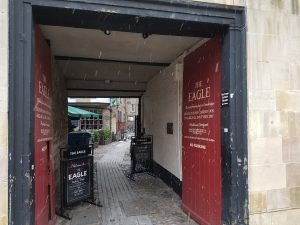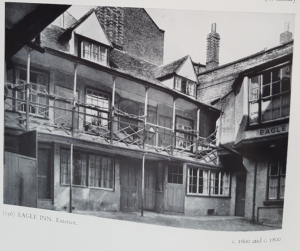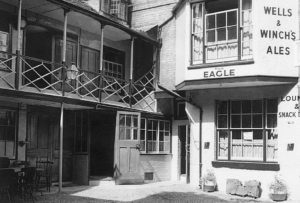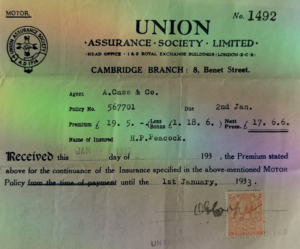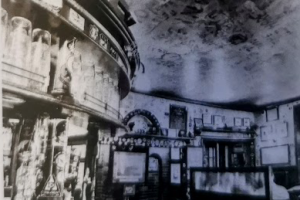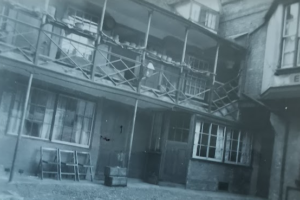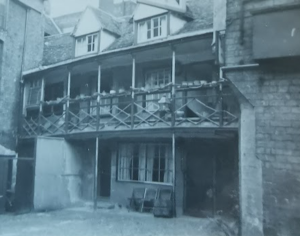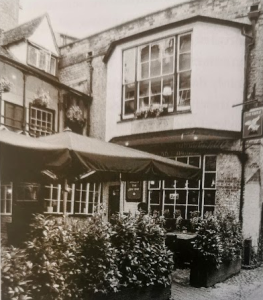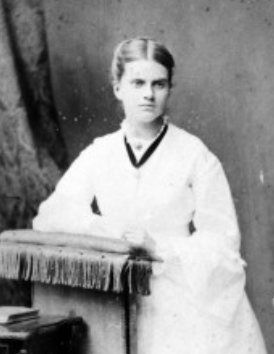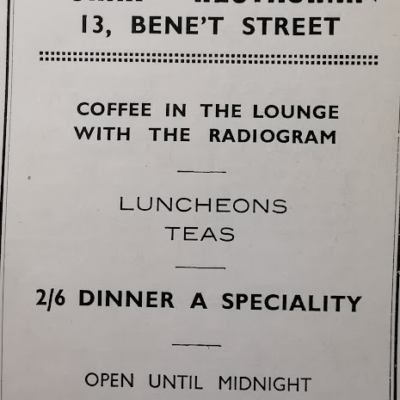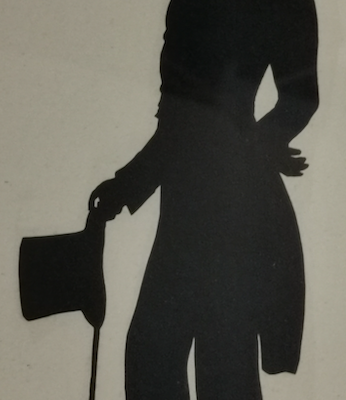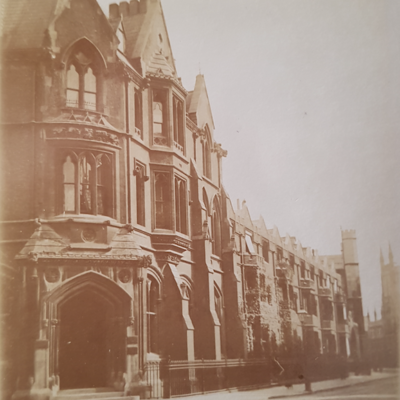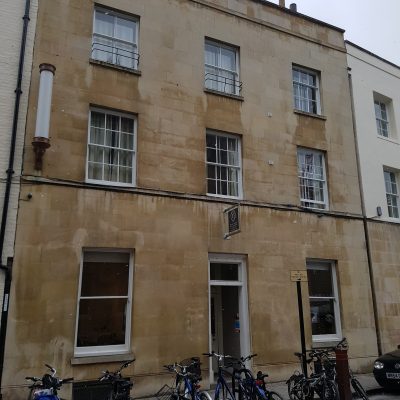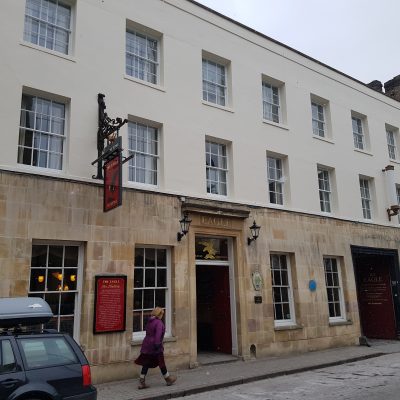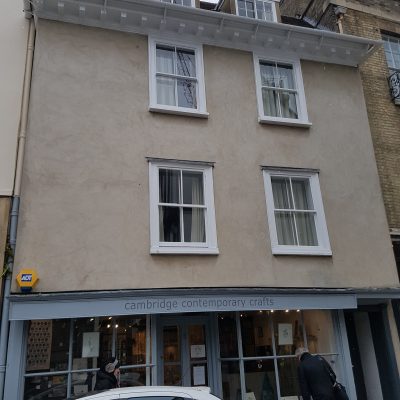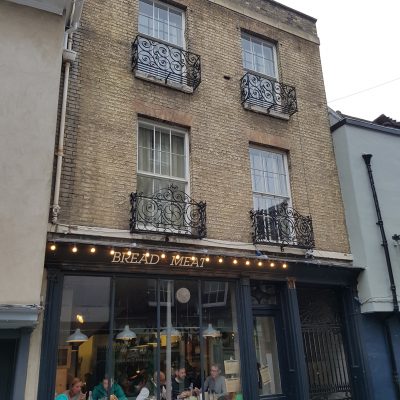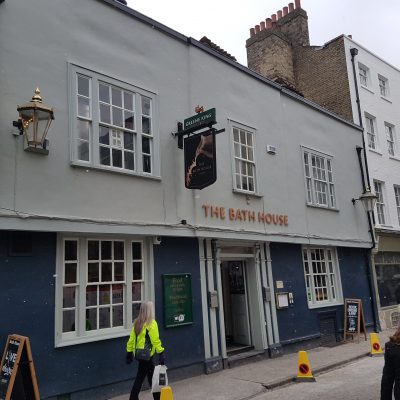Search by topic
- archaeology
- Building of Local Interest
- charity
- church
- crime
- dressmaker
- fire
- Great Eastern Railway
- Listed building
- Mapping Relief
- medieval
- oral history
- poverty
- Public House
- Rattee & Kett
- Religious House
- Roman
- scholar
- school
- Then and Now
- tudor
- women
- work
- world war one
- world war two
Search by text
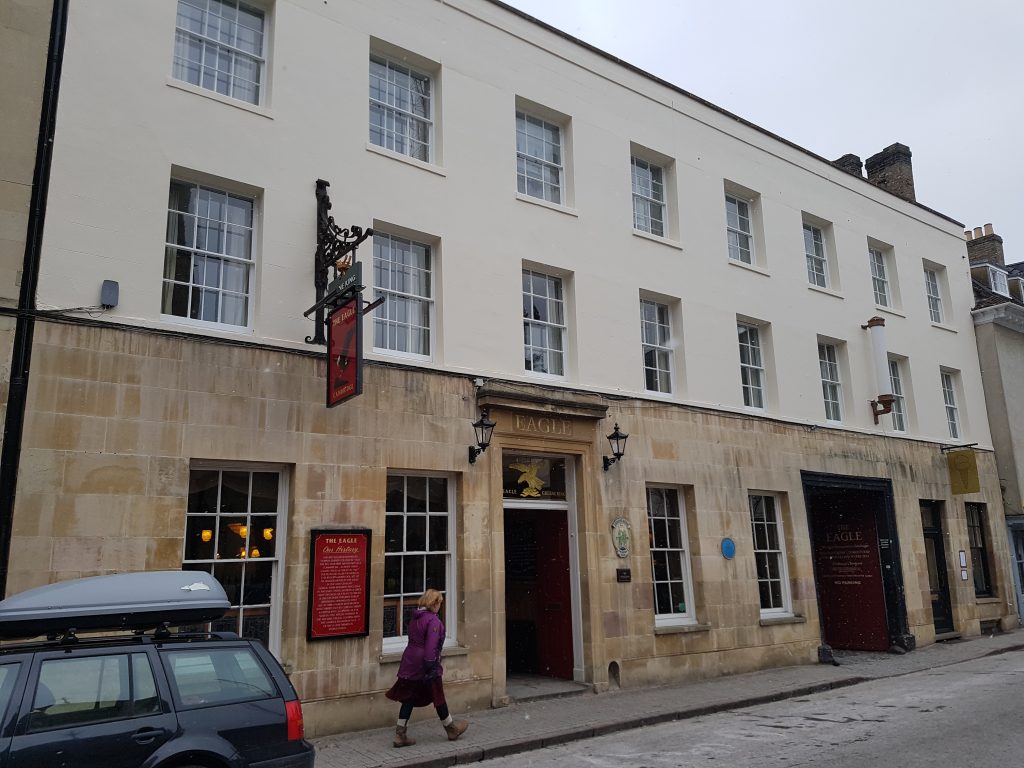
7 – 8 Bene’t Street, Eagle and Child, The Eagle
History of 8 Bene't Street
Corpus Christi College purchased the site around 1458. Soon after it was advertised as a property producing 20s per annum. A tavern had existed at this site since at least 1353 when Corpus was founded.
A lease to Andrew Pylkynton, innkeeper and his wife, in the archives of Corpus, dated 1566, mentions ” …. their two tenements, a greater and a lesser nowe made an Inne called the Eagle and Child sett and built together in the parishe of St Benett in Cambridge.” During the next century it was completely rebuilt.
The inn here opened in 1667 as the ‘Eagle and Child.” The Eagle and Child is the crest of the Earl of Derby.
According to 1959 Royal Commission on Historical Monuments Survey of Cambridge not. 9, 8, 6, 7 and 8 have all at one time been incorporated in the Inn, originally the ‘Eagle and Child’ and described as the Post House in Loggan’s plan of Cambridge in 1688. A lease of 1826 of the property is held by Corpus Christi College; in it no.9 is ‘newly erected’, ‘lately rebuilt by the Master and Fellows.’ The carriageway in the middle is in much the position of that shown in John Hamond’s view of Cambridge of 1592. The courtyard gallery front, though now of c.1800, seems to represent an original feature.
There is a Wikipedia article about the site:
https://en.wikipedia.org/wiki/The_Eagle,_Cambridge
Inside the eagle there are a number of places where old decorations have survived. In Bar 1 there are two areas of wall painting believed to date to around 1650. In the bedroom over Bar 2 broad green stripes were applied to cover up crooked timbers in the wall. This decoration might have been applied when the wing was built circa 1600.
1688 mentioned as the Post House on 1688 plan of Cambridge. Hammond’s 1592 plan of Cambridge shows a carriageway between nos. 6 and 8 Bene’t Street, but an1574 plan has no such entrance. This suggests that the inn was set up in the late 16th century but the foorings of the site may go back to the 12th or 13th century. (See Postal History of Cambridge by D J Muggleton, 1970).
John Mortlock, the Cambridge banker, formed the Rutland Club in 1782, a political group which had attached itself to the Reform party. The Eagle was their headquarters. By 1788, Mortlock was both Mayor of Cambridge and Member of Parliament.
c.1800: The Eagle was rebuilt with slate tiled roofs and timber and plaster walls infilled with brick. The gallery seems to be an original feature and the dormer windows in the roof have 17th century lead casements. (see Muggleton).
C.1820s: The Eagle Hotel was the headquarters of the Cambridge Tory party and was made full use of during elections. Before 1832, when Cambridge ceased to be a Rutland pocket borough, it was known as the Rutland Club and ‘The Ratland Feast’ published in the Independent Press in 1820 attacked the freemen and apostates who
‘For a glass of wine
Cringed at the Eagle once a month to dine.’
See Romilly’s diary, November 1842, editor’s note.
1842
The Plough and Fleece beer house was listed as lot 1 in the bankruptcy auction of James Nutter that took place on Thursday 26 May 1842 at 11am at the Eagle Inn in Cambridge.
1861
Eagle Hotel: Charles Turner, 43, hotel keeper, b Eynesbury
(8) Thomas Saunders, 53, hairdresser, b Cambridge
1871
Eagle: Sanders
(8) Turner
1881
Eagle:
(8) Clarke
1891
Charles W Hyde, 35, inn keeper, b Cambridge
(8) Edward C Clarke, 54, cook, b Cambridge
11/5/1907 A policeman described how he secreted himself in a larder and kept observation on the Eagle Inn, Bene’t Street. He could see who entered the yard and overhear conversation in the smoke-room on the other side of a lath and plaster wall. He heard talk relating to horse racing and telephonic messages being passed to certain address giving the names of horses and mentioning sums of money. Police raided the inn and the landlord was committed for trial. (Cam. News)
This photo is part of the Vanished Cambridge survey carried out by the Cambridge Antiquarian Survey. (See Mike Petty Fenland History on Facebook)
7/6/1943: Painting of an aircraft in flight, autographed by British and American service men has been subject of a competition in aid of Prisoners of War Fund at Eagle in Bene’t Street. Other men have covered ceiling with lipstick or lighter flame records of their own units (Cam News)
The ceiling of the bar is adorned by graffiti from Second World War airmen.
22/3/1951 Cambridge has some 150 inn signs hanging outside licensed premises. It is probable that Cambridge was the first place where public house signs were made compulsory by law. An Act passed in 1430 laid down “whoever shall brew ale in the town of Cambridge with intention of selling it must hang out a sign, otherwise he shall forfeit his ale. The Eagle and Child in Bene’t Street was called by irreverent undergraduates “The Bird and Baby”. There was also a “Swan and Sugarloaf’, (now the Still and Sugarloaf) which was nicknamed the Duck and Acid Drop. (Cam News)
1962
(7) The Eagle
18/4/1988 The historic Eagle Hotel in Bene’t Street has closed for a year or two while building work is carried out nearby. It has been favourite of tourists, dons and actors from the Arts Theatre. The people who discovered DNA were regulars and the traitor, Kim Philby, also drank there. Former RAF Chief Technician, James Chainey, who has made a study of the wartime writings on the ceiling, was among the final drinkers. But late arrivals found many of the pumps had already run dry and some of the fittings taken down. (Cam.News)
1981
(8) Hockeys, estate agent
1987
Former RAF Chief Technician, James Chainey, took on the task of deciphering the words and numbers on the ceiling.
2018
(8) The Eagle
A legend says that a top window in the courtyard is always left open to allow the ghosts of children to escape.
The Cambridge Ghost Book, Halliday and Murdie, 2000, recounts the tradition of two boys that died in mysterious circumstances who appear in the upstairs window. Others have seen a girl on a staircase.
Contribute
Do you have any information about the people or places in this article? If so, then please let us know using the Contact page or by emailing capturingcambridge@
License
This work is licensed under CC BY-NC-SA 4.0





